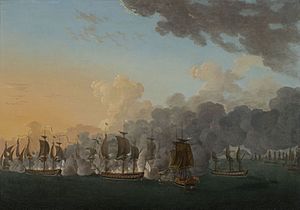Action of 21 July 1781 facts for kids
Quick facts for kids Action of 21 July 1781Combat naval en vue de Louisbourg |
|||||||
|---|---|---|---|---|---|---|---|
| Part of the American Revolutionary War | |||||||
 Combat Naval A La Hauteur De Louisbourg, Auguste-Louis de Rossel de Cercy |
|||||||
|
|||||||
| Belligerents | |||||||
| Commanders and leaders | |||||||
Rupert George Richard Peter Tonge (POW) |
|||||||
| Strength | |||||||
| 2 frigates | 6 frigates | ||||||
| Casualties and losses | |||||||
| 6 killed 34 wounded |
17 killed 48 wounded 2 frigates captured |
||||||
The Action of 21 July 1781 was a naval battle during the American Revolutionary War. It happened near Sydney, Nova Scotia. Two fast French ships, called frigates, fought against a group of 18 British ships. These British ships were protected by six of their own warships. The French managed to capture two of the British warships. The rest of the British ships escaped.
Why This Battle Happened
France Joins the American Revolution
France had lost its lands in Canada during the Seven Years' War. They wanted to get back at Britain. So, when the American Revolution started, France saw a chance. They secretly helped the Americans at first. Then, in 1778, France officially joined the war. They signed a deal with America called the Treaty of Alliance. This meant France and America would fight Britain together.
French Help for America
A French hero named Lafayette was already helping the American army. He went back to France and then returned to America. He brought news that more French help was coming. In 1780, a large French fleet arrived. This made the French naval presence much stronger.
The French Frigates' Mission
In June 1781, two French frigates were on a mission. Frigates are quick warships. They were designed for speed and had copper on their hulls to make them even faster. These ships were armed with 12-pounder guns. This made them stronger than most privateer ships. The two frigates were named Astrée and Hermione. They were led by Captain La Pérouse and Captain Latouche Tréville. Their job was to attack British merchant ships and smaller warships.
The British Convoy
On the morning of July 21, the French ships spotted a large group of 20 British ships. This group was called a convoy. It included 18 merchant ships, carrying coal and supplies. They were heading to Spanish River (now Sydney) to pick up more coal. Six British warships were protecting them. These escorts included the frigate Charlestown and several smaller ships.
The Battle Begins
The Chase and First Shots
As the French frigates got closer, the British escort ships moved to meet them. The rest of the British convoy tried to escape into Spanish River. The five main British warships formed a line to fight. This was a common battle tactic. Captain La Pérouse tried to stop the convoy from getting away. Around 6:30 PM, Astrée got close enough to fire her cannons. The French ships had an advantage. Their 12-pounder guns were more powerful than the British 9-pounder guns.
Capturing British Ships
Astrée focused its fire on the main British ship, Charlestown. Hermione then joined in, firing at Charlestown too. Charlestown was badly hit. It stopped moving. This allowed Astrée to fire at it again. Meanwhile, Hermione moved in close to another British ship called Jack. Hermione fired at Jack from very close range. Jack soon gave up. Shortly after, the main mast of Charlestown fell. Its captain was dead. Charlestown also surrendered.
The Escape and Aftermath
By nightfall, the three remaining British warships tried to escape. Hermione chased them. Astrée took control of Jack. Astrée signaled Hermione to take Charlestown. But Charlestown had made quick repairs and escaped in the darkness. The French ships chased her but couldn't find her. They gave up the chase around 10:00 PM.
The British escort ships were badly damaged. But the convoy still managed to get its coal. It then delivered the coal to Halifax.
Casualties
Six French sailors were killed, and 34 were wounded. On the British side, 17 sailors were killed, and 48 were wounded. The French ships had some damage but were able to make temporary repairs. They returned to Boston on August 17.
After the Battle
British Response
When the British learned about the battle, they sent three large frigates to find Astrée and Hermione. But the French ships were already safe in Boston.
Captured Ships and Prisoners
Captain Tonge of the captured British ship Jack was taken prisoner to Boston. The French sent Jack to Boston with a small crew. They had also captured four other British merchant ships in the days before this battle. However, the British later recaptured two of these merchant ships. Jack was eventually sold in Salem. It was recaptured by the British the next year.
A Brave Opponent
La Pérouse and Latouche were first annoyed that Charlestown had escaped. But they felt sad when they learned that Captain Evans of Charlestown had died from his wounds. La Pérouse called him "a very brave man."
Painting of the Battle
Years later, in 1788, a large painting of this battle was made by Rossel de Cercy. You can see this painting today at the Musée national de la Marine in Paris.
Images for kids
-
Lapérouse in 1778, then a Lieutenant
-
Capt Henry Francis Evans Memorial, St. Paul's Church (Halifax), Nova Scotia






